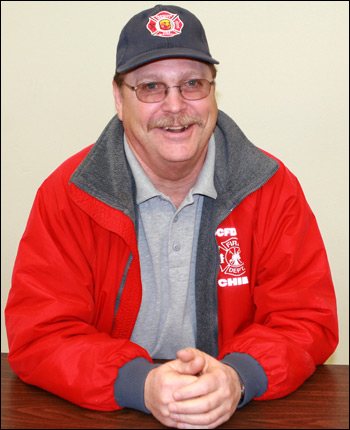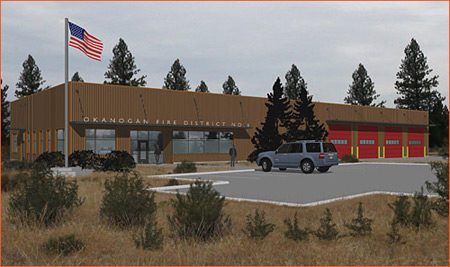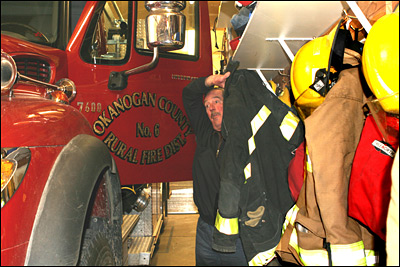home | internet service | web design | business directory | bulletin board | advertise | events calendar | contact | weather | cams

|
Growing Pains  Okanogan County Fire District 6 Chief Don Waller. -Photo by
Solveig Torvik Okanogan County Fire District 6 Chief Don Waller. -Photo by
Solveig TorvikOkanogan County Fire District 6 will put a $3 million levy proposal before voters next year to build a new Winthrop fire station, according to Chief Don Waller. “We’ve outgrown this piece of property,” he said. And, in a move that would require voter approval, the fire district has offered to take over fire fighting duties for the Town of Twisp, which has equipment problems with its own volunteer fire department. A tour of Winthrop’s fire station, housed in a former auto repair shop at 223 Englar St., quickly reveals the difficulties. Five vehicles are tightly crammed into the building, which is too short, too low and too narrow. Where there’s supposed to be a four-foot clearance around the fire engines to allow firefighters access to perform equipment safety checks, there’s just two feet at most, and in some places, only four inches of clearance. Two inches separate the front bumper of one fire engine from the bay door. The doors on many vehicles cannot be fully opened, and firefighters - who should be donning their gear in a room separated from the vehicle bays - must struggle into their protective suits in a space next to a fire engine that’s so narrow it interferes with the driver’s access to the rig. Because the 10-foot bay doors and 12-foot ceilings are two feet too short, says Waller, firefighters cannot perform needed equipment checks from the top of the vehicles, and some of today’s newer fire engines won’t fit in the building. This operating situation doesn’t comply with prescribed standards, says Waller. Nor is it an ideal blueprint for quick response to fires. It’s not a dramatic impediment to rapid response, he says. But, Waller admits, “It does delay it some.” He adds that there may be trouble from the state’s Department of Labor and Industries because the substandard working conditions pose safety hazards for firefighters. The fire district has purchased five treed acres on lower Horizon Flats Road in Winthrop. If the levy passes, the fire district in 2014 will remove the trees and build a 20-foot high, 12,000-square foot station to house six engines, plus overnight sleeping and food preparation facilities for firefighters, a decontamination room, and an emergency public shelter on the property, according to Waller, 57, who has been in the local fire fighting business for 40 years.
The Town of Winthrop, which has a $44,000 a year contract with the fire district to provide fire- fighting service, owns the Englar Street building. The new building would be owned by the fire district. Twisp, on the other hand, operates its own volunteer fire fighting service and has its own equipment. But it shares its building on Second Avenue with Fire District 6, and, in confusing fact, the volunteer firefighters for both entities actually are the same people, says Waller. Theoretically, Twisp’s firefighters answer calls in town. When they put on their Fire District 6 hats, it’s to fight fires outside Twisp town limits. However, the fire district, worried over the substandard state of Twisp’s equipment, has offered to permanently take over responsibility for firefighting inside Twisp city limits. For example, firefighters’ air packs are supposed to be pressure tested and inspected every five years. That hasn’t happened, says Waller, and only one of the eight tanks is operable. The two entities normally provide backup for one another when responding to fires, but Waller says the situation with Twisp’s equipment poses an unacceptable liability for the fire district. One solution is for Twisp voters to ask the fire district to annex it into the district, which would then provide services on a contract as it does in Winthrop. Existing members of the entire fire district would also have to agree to the annexation, so two measures would be put before voters on a ballot. That couldn’t happen until November at the earliest, according to Waller. In the meantime town council and district officials are trying to devise a short-term solution, and a proposal will be brought to the council at the April 10 town council meeting, according to Twisp Town Council member Clint Estes. Twisp doesn’t have a volunteer fire chief at the moment, Estes said. Asked to explain why the town’s firefighting equipment has not been properly maintained, he attributed it to the volunteer nature of the department. “It fell through the cracks. It shouldn’t have happened.” He added that the council and fire district officials generally agree that annexing the town into the district is the sensible solution. “It’s a no brainer,” said Estes, who serves on the council committee that oversees the fire department. Though it bears the county’s name, Fire District 6 is not a creature of the county and does not answer to the county commissioners. It has its own three commissioners, one of them elected every two years. They are Roy Rieber, Darold Brandenburg and Jerry Palm. 
The design for the new station. – Photo from Okanogan County Fire District 6 Fire District 6 was established as a junior taxing district in the early 1960s, according to Waller. It runs from Lost River to Gold Creek, though it answers calls to assist with its Jaws of Life equipment at auto accidents as far away as Washington Pass. In addition to Twisp and Winthrop, it has fire stations in Carlton and Mazama. ”A lot of people don’t understand that they’re not in the fire district,” explains Waller. Those living beyond the periphery of the core settlement in the lower Methow aren’t included in the taxing district. If they receive firefighting services, they’re sent a bill. The district has an annual operating budget of roughly $620,000, says Waller, and has no debt aside from state-sponsored revolving loans used to purchase firefighting vehicles, which cost about $300,000 each. “We’re continually buying equipment,” says Waller. “We can’t replace them as fast as we really should.” The next purchase will be an efficient “urban interface” engine for the district’s Twisp operation that can fight both structure and wildland fires, he says. The Winthrop station already has one. “Nothing in fire fighting is cheap,” adds Waller. Fire hose costs $2 a foot and an air pack costs $3,500; the district has 29 of them. There are four full-time paid officials in the district and 35 volunteers. Overall, those volunteers answer 200 calls a year. “We pay them $10 a call,” Waller says, and they must spend a minimum of two hours each week in training and many more to become fully trained for all types of firefighting. “It takes a family that’s willing to cooperate. It takes family support.” Volunteer Winthrop fire station captain John Owen, a retired engineer, adds that being a volunteer firefighter requires not only time but dedication and passion. “When I retired and got a chance to give back, I said, ‘Yipee!’’ he laughs. “Our biggest problem is daytime fire responses,” adds Waller, because the volunteers usually have jobs. “Most employers won’t let volunteer firefighters leave,” he says. He’s reluctant to complain about this, saying he fears employers may not hire his volunteers. But he points out, “If you don’t have a volunteer fire department, your insurance goes up.” 4/4/2012 Comments winthrop is currently in fire class 6; outer areas are class 8. fire insurance premiums for class 8 are 40 to 60% higher than class 6. expanding okanogan fire distrrict 6 service area has the potential of winthrop losing its' lower rated class. on a $300,000 building the insurance premium could increase by $250 due to this change. residents need verfification that class 6 rating will be maintained before okanogan district 6 takes over twisp. Duncan Bronson Winthrop Chief Waller: I would like to respond to the question posed in our phone conversation this afternoon: When an incorporated city is annexed into a fire protection district, the city maintains its separate grading. The city does not automatically take the Protection Class of the fire protection district. While the fire department section of the grading would be the same for the fire district and the city, other items would be different. The example you mentioned (Okanogan FPD 6 and Winthrop) is typical of other similar cities that have been annexed into fire protection districts throughout Washington State. The town of Winthrop (Protection Class 6) has been annexed into Okanogan County FPD No. 6 (Protection Class 8), but because the town is incorporated, it continues to be evaluated separately from the district. If you have other questions, feel free to contact me. Kelly McGougan Washington Surveying and Rating Bureau 4407 North Division Street, Suite 502 Spokane, Washington 99207 509-228-8064 kelly.mcgougan@wsrb.com Submitted by Brian McAuliffe Winthrop In 2010, the construction bond request was for $5 million. What has changed in the design that it is now possible to build for $3 million? Brian Drye Winthrop |
 John Owen, volunteer captain at Winthrop's fire station, illustrates the crowded space in which firefighters must don their gear. - Photo by Solveig Torvik.
John Owen, volunteer captain at Winthrop's fire station, illustrates the crowded space in which firefighters must don their gear. - Photo by Solveig Torvik.